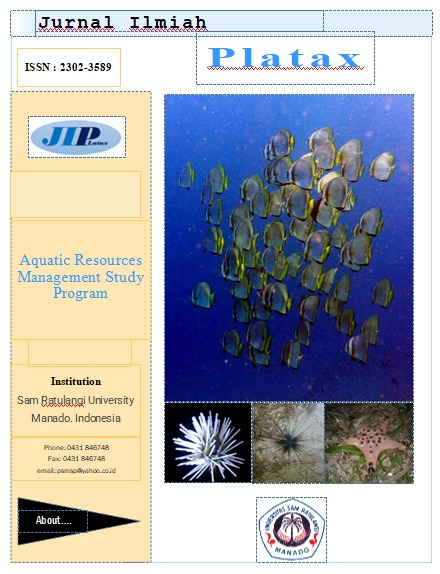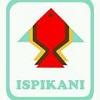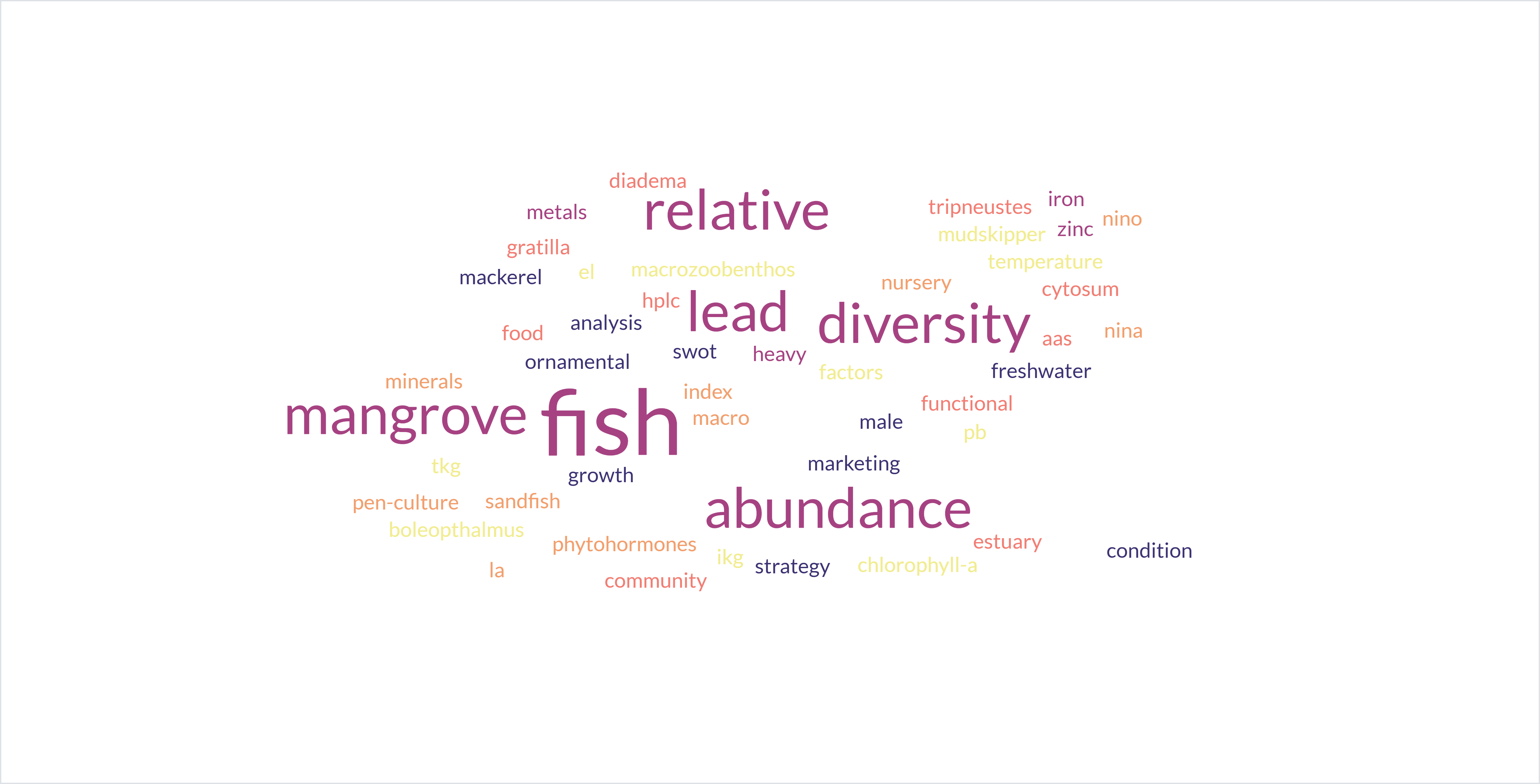Benefit Value of Mangrove Forest in Sarawet Village, Likupang Timur, Minahasa Utara
DOI:
https://doi.org/10.35800/jip.v10i2.41499Keywords:
direct benefit value, indirect benefit value, total economic value, MangroveAbstract
The purpose of this study is to: 1) identify various types of direct and indirect benefits of mangrove forests, and 2) estimate the total economic value of the mangrove forest in Sarawet Village. This type of research is descriptive and quantitative using survey methods. Data analysis in this study uses descriptive and quantitative analysis. Descriptive analysis is used to explain the activities of utilizing natural resources of mangrove ecosystems, while quantitative analysis is used to calculate the total economic value of mangrove ecosystems. The selection of respondents used the purposive sampling method, with a total of 76 respondents. Analysis of the total economic value for the value of direct benefits using market prices, and the value of indirect benefits using replacement costs. The results showed that the people of Sarawet Village use the mangrove forest ecosystem directly in the form of mangrove wood used as firewood and fence stakes, leaves Nipah are made with roofs, and the community carries out fishing and crab activities around mangrove waters.
Analysis of the total economic value of the mangrove forest in Sarawet Village amounted to Rp. 6.884.344.178,-/year. The total economic value is obtained from the value of direct benefits including utilization as firewood Rp. 4,160,000,- /year; fence pegs Rp. 87.500,-/year; roof of the house Rp. 330.000,-/year; fishing Rp. 769.174.000,-/year; crab fishing is Rp. 190.320.000,-/year, and the value of indirect benefits is as a barrier to abrasion and seawater waves Rp. 5.920.272.678,-/year. The large economic value of the total mangrove forest ecosystem in Sarawet Village shows that the mangrove ecosystem provides great benefits to the community.
Keywords: direct benefit value, indirect benefit value, total economic value, Mangrove
Abstrak
The purpose of this study is to: 1) identify various types of direct and indirect benefits of mangrove forests, and 2) estimate the total economic value of the mangrove forest in Sarawet Village. This type of research is descriptive and quantitative using survey methods. Data analysis in this study uses descriptive and quantitative analysis. Descriptive analysis is used to explain the activities of utilizing natural resources of mangrove ecosystems, while quantitative analysis is used to calculate the total economic value of mangrove ecosystems. The selection of respondents used the purposive sampling method, with a total of 76 respondents. Analysis of the total economic value for the value of direct benefits using market prices, and the value of indirect benefits using replacement costs. The results showed that the people of Sarawet Village use the mangrove forest ecosystem directly in the form of mangrove wood used as firewood and fence stakes, leaves Nipah are made with roofs, and the community carries out fishing and crab activities around mangrove waters.
Analysis of the total economic value of the mangrove forest in Sarawet Village amounted to Rp. 6.884.344.178,-/year. The total economic value is obtained from the value of direct benefits including utilization as firewood Rp. 4,160,000,- /year; fence pegs Rp. 87.500,-/year; roof of the house Rp. 330.000,-/year; fishing Rp. 769.174.000,-/year; crab fishing is Rp. 190.320.000,-/year, and the value of indirect benefits is as a barrier to abrasion and seawater waves Rp. 5.920.272.678,-/year. The large economic value of the total mangrove forest ecosystem in Sarawet Village shows that the mangrove ecosystem provides great benefits to the community.
Keywords: direct benefit value, indirect benefit value, total economic value, Mangrove.
References
Anneboina LR, Kumar KSK. 2017. economic analysis of mangrove and marine fishery linkages in India. ELSEVIER. Ecosystems Services. 24: 114-123
Burhan, Bungin. 2010. Metodologi Penelitian Kualitatif. PT. Raja Grafindo Persada. Jakarta.
Costanza R, de Groot R, Farberk S, Grasso M, Hannon B, Limburg K, Naeem S, O’Neill RV, Paruelo J, Raskin RG, Sutton P, van den Belt M.1997. The value of the world’s ecosystem services and natural capital. Nature. Vol. 387.
Dahuri, R,.J. Rais.,S.P.Ginting.,M.J.Sitepu. 2013. Pengelolaan Sumberdaya Wilayah Pesisir dan Lautan Secara Terpadu. PT Balai Pustaka.Jakarta.
Das S. 2017. Ecological restoration and livelihood: contribution of planted mangroves as nursery and habitat for artisanal and commercial fishery. World Development. 94:492-502
Eddy, S., Ridho, M. R. dan Iskandar, I. 2015. Dampak Aktivitas Antropogenik terhadap Degradasi Hutan Mangrove di Indonesia. Jurnal Lingkungan dan Pembangunan, 1(3): 240-254.
Fadhila, Hilda, Saputra, Suradi W., Wijayanto, Dian. (2015). Nilai Manfaat Ekonomi Ekosistem Mangrove di Desa Kartika Jaya Kecamatan Patebon Kabupaten Kendal Jawa Tengah. Fakultas Perikanan dan Ilmu Kelautan Universitas Diponegoro. Jawa Tengah.
Fahrudin A. 1996. Analisis Ekonomi Pengelolaan Lahan Pesisir Kabupaten Subang, Jawa Barat. [Tesis]. Bogor (ID): Institut Pertanian Bogor.
Farrugia B. 2019. WASP (Write a Scientific Paper): Sampling in qualitative research. Early Human Development. 133: 69-71
Fauzi A. 2002. Persepsi Terhadap Nilai Ekonomi Sumberdaya. [Bahan Pelatihan]. Pengelolaan Wilayah Pesisir Terpadu. Bogor. Institut Pertanian Bogor.
Fauzi A. 2014. Valuasi Ekonomi dan Penilaian Kerusakan Sumberdaya Alam dan Lingkungan. Bogor (ID): IPB Press
Groombridge B. 1992. Global biodiversity. Status of The Earth’s Living Resources. A Report Compiled by the World Conservation Monitoring Centre. London, Glasgow, New York, Tokyo, Melbourne, Ma-dras: Chapman & Hall
Kalitouw, Winda Desitha. 2015. Valuasi Ekonomi Hutan Mangrove di Desa Tiwoho Kecamatan Wori Kabupaten Minahasa Utara. Jurusan Sosial Ekonomi Pertanian Universitas Sam Ratuangi, Manado.
Kustanti A. 2011 Manajemen Hutan Mangrove. Bogor(ID). PT. Penerbit Institut Pertanian Bogor
Lasabuda, R., Lumingas, L., & Mantiri, R. 2016. Mangrove Community Characteristics and Local Fishermen’s Utilization in North Sulawesi Province: Case study on boat raft fishermen in Sauk village, Labuan Uki bay, Bolaang Mongondow regency. Jurnal Ilmiah PLATAX, 4(2), 139-148. doi:https://doi.org/10.35800/jip.4.2.2016.19011
Menéndez P, Iňigo JL, Michael WB, Saul T, Antonio E, Siddharth N, Pedro D, Glenn-Marie L. 2018. Valuing the protection services of mangroves at national scale: The Philippines. ELSEVIER. Ecosystem Services. 34:24-36.
Nahib, I. 2004. Pengelolaan Sumberdaya Tidak Pulih Berbasis Ekonomi Sumberdaya. Jurnal Ilmiah Geomatika. Pusat Survei Sumberdaya Alam Laut. Bakosurtanal. 12 (1) : 37-50.
Noor, Y. R., M. Khazali, I. N. N. Sijryadipura. 2006. Panduan Pengenalan Mangrove di Indonesia. PKA/WI-IP, Bogor: 220 hal.
Peraturan Menteri PUPR No. 1 Tahun 2022 tentang Pedoman Penyusunan Perkiraan Biaya Pekerjaan Konstruksi Bidang Pekerjaan Umum dan Perumahan Rakyat (Bagian II: Analisis Harga Satuan Pekerjaan Bidang Sumber Daya Air).
Qodrina, L, Hamidy R., Zulkarnaini. 2012. Valuasi Ekonomi Hutan Mangrove di Desa Teluk Pambang Kecamatan Bantan Kabupaten Bengkalis Provinsi Riau. Jurnal Ilmu Lingkungan. Universitas Riau. Pekanbaru. 6 (2) : 93-98. ISSN: 1978-5283.
Santoso, N., R. P. Nugraha, R. Andalas. 2019. Nilai Ekonomi Total Hutan Mangrove Kawasan Desa Pangkah Kulon dan Pangkah Wetan, Kecamatan Ujungpangkah, Kabupaten Gresik, Provinsi Jawa Timur. Jurnal Media Konservasi Vol. 24 No. 2 Agustus 2019: 152-162
Tanner, MK., Nicolas M., Matthew TC., Jose RMJ., Octavio A, Pelayo S. 2019. Mangroves in the Galapagos: ecosystem services and their valuation. ELSEVIER. Ecological Economics. 160:12-24.
Walters, B., Ronnback, P., Konvacs, J., Crona, B., Hussain, S., Badola, R., Primavera, J., Barbier, E., Dahdouh-Guebas, F. 2008. Ethnobiology, socio-economics and management of mangrove forests: A review. Aquatic Botany 89:220–236.
Downloads
Published
How to Cite
Issue
Section
License
COPYRIGHT
Authors who publish with this journal agree to the following terms:
Authors hold their copyright and grant this journal the privilege of first publication, with the work simultaneously licensed under a Creative Commons Attribution License that permits others to impart the work with an acknowledgment of the work's origin and initial publication by this journal.
Authors can enter into separate or additional contractual arrangements for the non-exclusive distribution of the journal's published version of the work (for example, post it to an institutional repository or publish it in a book), with an acknowledgment of its underlying publication in this journal.
Authors are permitted and encouraged to post their work online (for example, in institutional repositories or on their website) as it can lead to productive exchanges, as well as earlier and greater citation of the published work (See The Effect of Open Access).




















